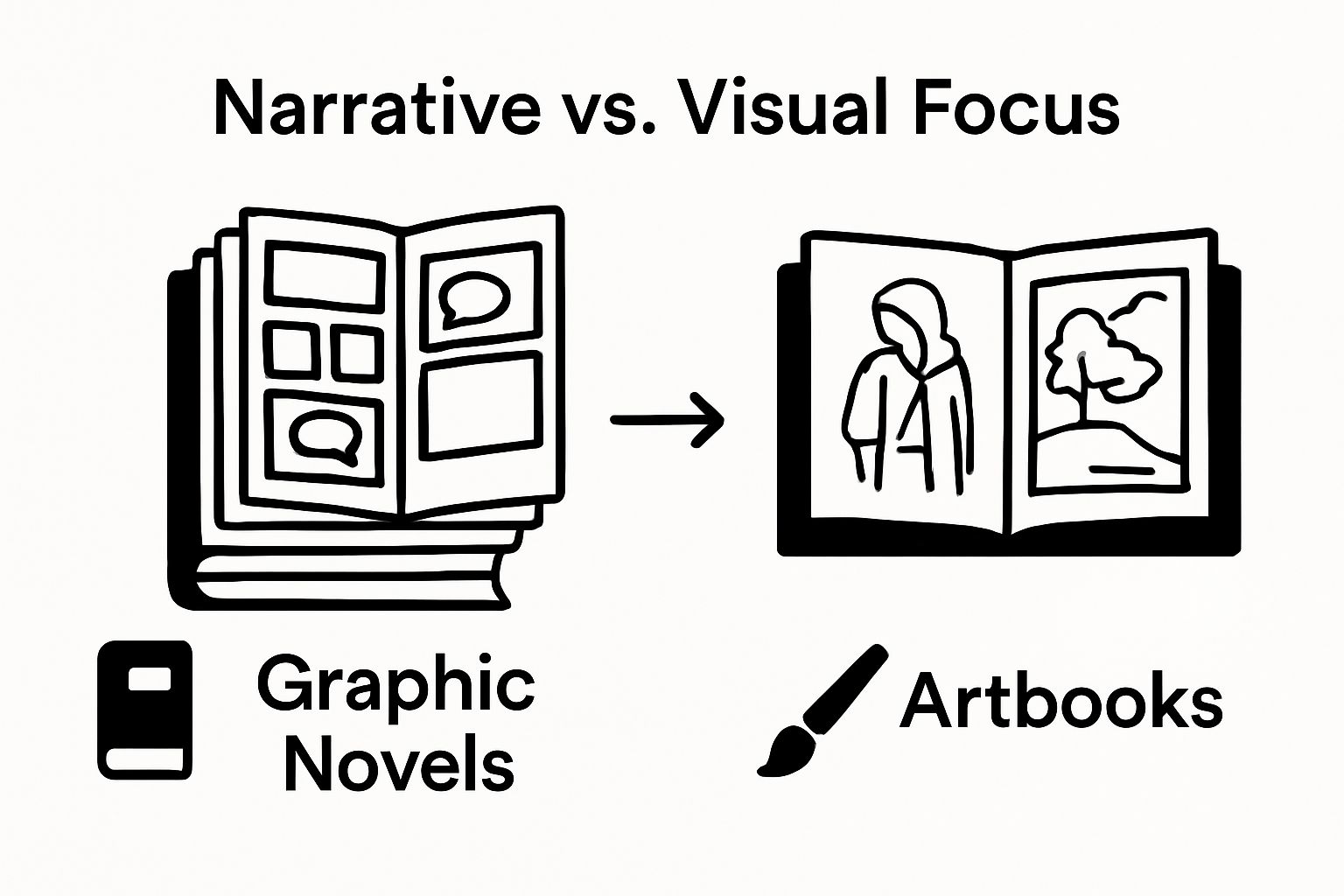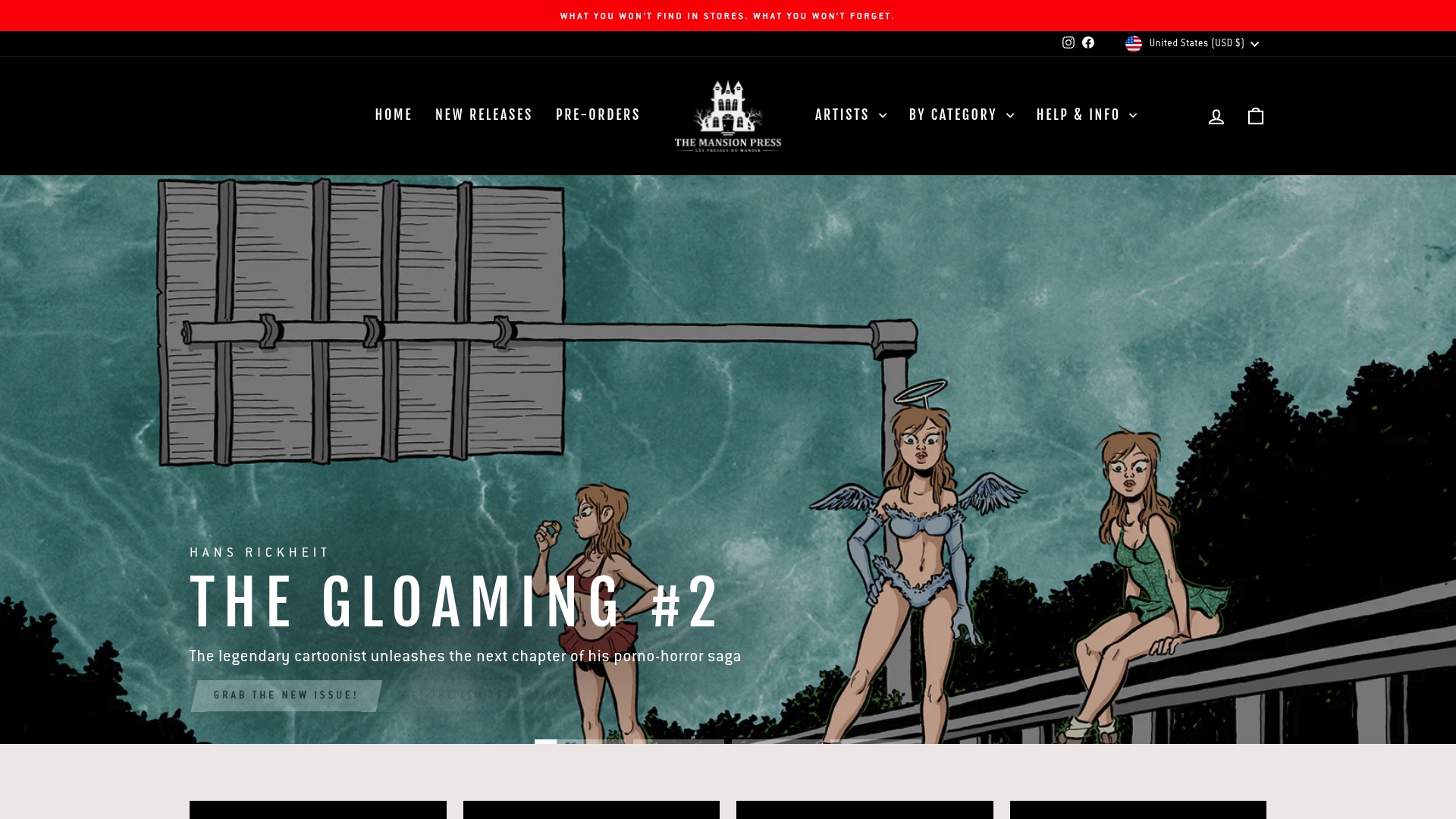Understanding Graphic Novels versus Artbooks Explained
Graphic novels and artbooks shape the way we experience stories and art today. Over 65 percent of graphic novel collectors are aged between 18 and 45, and their numbers keep growing each year. Most people think these books are just for kids or hobbyists. The real surprise is how these visual mediums now drive cultural discussions, academic research, and even spark major shifts in the art world.
Table of Contents
- Defining Graphic Novels And Artbooks: Key Characteristics
- The Cultural Significance Of Graphic Novels And Artbooks
- Exploring The Creative Process Behind Graphic Novels And Artbooks
- Understanding The Audience: Who Collects Graphic Novels And Artbooks
- The Future Of Graphic Novels Versus Artbooks In Art And Literature
Quick Summary
| Takeaway | Explanation |
|---|---|
| Graphic novels offer complex narratives. | They present intricate storytelling with developed characters and mature themes, often aimed at adult audiences. |
| Artbooks emphasize artistic presentation. | Focused on showcasing artwork, they provide visual compilations without narrative constraints, highlighting artistic techniques. |
| Both mediums hold cultural significance. | Graphic novels address societal issues; artbooks document artistic evolution, serving as important cultural artifacts. |
| Collectors engage with diverse artistic communities. | Enthusiasts range from academics to artists, reflecting a shared appreciation for visual storytelling and cultural dialogue. |
| Digital trends reshape graphic novels and artbooks. | Emerging technologies enhance storytelling through interactive formats and innovative artistic expressions, expanding creative possibilities. |
Defining Graphic Novels and Artbooks: Key Characteristics
Graphic novels and artbooks represent two distinct yet interconnected visual storytelling mediums that capture artistic expression through unique approaches. While they might seem similar at first glance, understanding their fundamental differences becomes crucial for art collectors, comic enthusiasts, and creative professionals.
Graphic Novels: Narrative Visual Storytelling
Graphic novels are sophisticated sequential art forms that combine elaborate artwork with complex narrative structures. Unlike traditional comic books, these visual narratives often tell complete stories with intricate character development, profound themes, and sophisticated storytelling techniques. The Comic Book Legal Defense Fund describes graphic novels as long-form comic book narratives that explore comprehensive storylines across multiple chapters.
Key characteristics of graphic novels include:
- Comprehensive narrative arcs spanning entire volumes
- Complex character development and thematic exploration
- More mature and nuanced storytelling approaches
- Often targeted at adult audiences
- Usually bound like traditional books with substantial page counts
Artbooks: Visual Compilation and Artistic Showcase
Artbooks, in contrast, prioritize visual aesthetics and artistic presentation over linear storytelling. These compilations serve as curated collections showcasing an artist’s portfolio, design concepts, or specific artistic styles. Society of Visual Storytellers notes that artbooks function as comprehensive visual references that document creative processes and artistic evolution.
Primary characteristics of artbooks include:
- Collections of artwork without sequential narrative requirements
- Focused on visual representation and artistic technique
- Showcase original concept art, sketches, and design explorations
- Often created by individual artists or design studios
- Emphasize aesthetic quality and visual documentation
While graphic novels and artbooks differ in their primary objectives, they both represent powerful mediums for visual communication.
To help clarify the distinctions between graphic novels and artbooks, the table below compares their key characteristics side by side.
| Feature | Graphic Novels | Artbooks |
|---|---|---|
| Primary Purpose | Narrative storytelling through sequential art | Visual compilation and artistic showcase |
| Structure | Structured plot with character development | No fixed narrative; curated selection of artwork |
| Target Audience | Often adults; complex themes and stories | Artists, designers, collectors, art enthusiasts |
| Content Style | Uses panels, dialogue, and progression | Focuses on art, sketches, concepts, and commentary |
| Artistic Focus | Integrated art supports narrative | Art is the focus; analysis of techniques |
| Physical Format | Book-bound with high page count | Range from books to portfolios, often high quality |
| Cultural Role | Social commentary and diverse narratives | Preserves creative processes and artistic evolution |
The Cultural Significance of Graphic Novels and Artbooks
Graphic novels and artbooks have evolved far beyond simple entertainment, emerging as powerful cultural artifacts that reflect societal narratives, artistic innovation, and intellectual discourse. These visual mediums transcend traditional boundaries, offering profound insights into human experiences and creative expression.
Narrative and Social Commentary
Graphic novels have become critical platforms for addressing complex social issues and marginalized perspectives. University of Chicago Press highlights how these visual narratives provide unique opportunities to explore nuanced cultural dialogues through compelling storytelling and visual representation. Artists and writers utilize graphic novels as vehicles for social critique, presenting challenging themes with accessibility and emotional depth.
Key cultural contributions of graphic novels include:
- Amplifying voices from underrepresented communities
- Translating complex historical and political narratives
- Challenging mainstream narrative structures
- Providing alternative perspectives on social issues
- Creating empathetic connections through visual storytelling
Artistic Documentation and Visual Preservation
Artbooks serve critical roles in documenting artistic evolution and preserving creative processes. These compilations function as historical records, capturing the developmental stages of artistic movements and individual creative journeys. International Association of Art Critics emphasizes artbooks as essential archival resources that chronicle visual culture across different periods and artistic disciplines.
Significant aspects of artbooks in cultural preservation include:
- Recording design and conceptual development
- Archiving contemporary artistic practices
- Providing insights into creative methodologies
- Establishing visual reference points for future generations
- Celebrating individual and collective artistic achievements
Both graphic novels and artbooks represent more than mere visual media.
 They are dynamic cultural instruments that challenge perceptions, document human experiences, and provide nuanced platforms for creative expression.
They are dynamic cultural instruments that challenge perceptions, document human experiences, and provide nuanced platforms for creative expression.
By bridging storytelling, social commentary, and artistic documentation, these mediums continue to reshape our understanding of visual communication and cultural narrative.
Exploring the Creative Process Behind Graphic Novels and Artbooks
The creation of graphic novels and artbooks represents a complex, multifaceted artistic journey that requires immense creativity, technical skill, and strategic storytelling. Each medium demands unique approaches to visual communication and narrative development, revealing intricate creative methodologies that transform initial concepts into compelling visual experiences.
Graphic Novel Development: Narrative Construction
Carnegie Mellon University outlines the graphic novel creation process as a collaborative and iterative endeavor involving multiple specialized stages. Artists and writers work together to transform abstract narrative concepts into visually engaging storytelling experiences that communicate complex emotions and ideas.
The graphic novel development process typically involves:
- Initial narrative conceptualization and scripting
- Detailed storyboarding and scene composition
- Character design and visual character development
- Panel layout and sequential storytelling techniques
- Iterative editing and narrative refinement
Artbook Curation: Visual Compilation
Artbook creation differs significantly from graphic novels, focusing on curating and presenting visual artwork as a comprehensive collection. These compilations require meticulous selection, arrangement, and presentation of artistic works to create meaningful visual narratives. Artists and designers carefully consider how individual pieces interact and communicate broader artistic themes.
Key aspects of artbook creation include:
- Selecting representative artwork pieces
- Designing visual flow and thematic progression
- Creating contextual commentary and artist insights
- Determining aesthetic presentation and layout
- Balancing visual diversity with conceptual coherence
Both graphic novels and artbooks demonstrate that visual storytelling extends far beyond simple image reproduction.
The following table summarizes the main creative processes and steps for producing graphic novels and artbooks, offering an at-a-glance comparison of each medium’s approach.
| Process Stage | Graphic Novels | Artbooks |
|---|---|---|
| Initial Development | Story scripting and concept creation | Curating and selecting representative artwork |
| Structure/Planning | Storyboarding and panel layout | Designing visual flow and thematic arrangement |
| Production Focus | Character design and sequential art | High-quality art reproduction and layout |
| Iteration and Refinement | Editing script, scenes, and visuals | Contextual commentary and artist insights |
| Completion and Assembly | Binding complete narrative as a book | Arranging final artwork into a cohesive collection |
| End Result | Illustrated story with developed narrative | Visual archive showcasing artistic evolution |
Understanding the Audience: Who Collects Graphic Novels and Artbooks
The audiences for graphic novels and artbooks represent diverse communities of passionate collectors, artists, and enthusiasts who value visual storytelling and creative expression. These communities extend far beyond traditional consumer demographics, encompassing individuals with sophisticated artistic sensibilities and deep cultural interests.
Graphic Novel Collector Demographics
Comic Book Legal Defense Fund reveals that graphic novel collectors represent a remarkably diverse and intellectually curious audience. These collectors are not confined to a single age group or background but include academics, art professionals, literature enthusiasts, and individuals seeking complex narrative experiences through visual mediums.
Key characteristics of graphic novel collectors include:
- Aged between 18 and 45 years old
- Higher than average educational attainment
- Strong interest in multicultural narratives
- Appreciation for complex storytelling techniques
- Active engagement with contemporary social issues
Artbook Collector Profiles
Artbook collectors represent a specialized group of visual art enthusiasts who prioritize aesthetic appreciation and artistic documentation. These individuals often have professional or personal connections to design, illustration, animation, and visual arts. Their collections serve as personal archives and reflections of artistic exploration.
Distinctive traits of artbook collectors include:
- Professional artists and designers
- Academic researchers in visual arts
- Serious hobbyists and creative professionals
- Collectors of limited edition and rare artistic publications
- Individuals passionate about documenting creative processes
Both graphic novel and artbook collectors share a fundamental appreciation for visual storytelling as an intellectual and emotional medium. Their collecting practices represent more than simple consumption they are active forms of cultural engagement and artistic preservation.

The Future of Graphic Novels versus Artbooks in Art and Literature
The evolving landscape of visual storytelling and artistic documentation presents dynamic opportunities for graphic novels and artbooks, transforming how we perceive and interact with creative media. Emerging technologies, changing cultural paradigms, and innovative artistic practices are reshaping these mediums in unprecedented ways.
Digital Transformation and Technological Integration
MIT Technology Review highlights the significant impact of digital platforms on graphic novels and artbooks. Technological advancements are creating immersive experiences that blend traditional artistic formats with interactive digital interfaces, expanding the potential for storytelling and artistic expression.
Key technological developments include:
- Augmented reality interactive graphic novel experiences
- Digital artbook platforms with multimedia content
- Blockchain technologies for artist authentication
- Advanced digital illustration and design tools
- Cross-platform publishing and distribution methods
Emerging Artistic and Narrative Trends
Contemporary graphic novels and artbooks are increasingly challenging traditional boundaries, incorporating interdisciplinary approaches that merge visual art, social commentary, and experimental storytelling. Artists are developing more nuanced, complex narratives that transcend conventional genre limitations and explore innovative representational techniques.
Significant emerging trends encompass:
- Hybrid narrative formats combining multiple artistic disciplines
- Greater representation of marginalized perspectives
- Increased global cultural exchange and collaboration
- Experimental storytelling techniques
- Integration of personal and collective historical narratives
The future of graphic novels and artbooks represents a dynamic intersection of technological innovation, artistic exploration, and cultural dialogue. These evolving mediums will continue to challenge our understanding of visual storytelling, offering increasingly sophisticated platforms for creative expression and intellectual engagement.
Bring Your Passion for Visual Storytelling to Life
Are you fascinated by the powerful storytelling of graphic novels or the stunning creativity displayed in artbooks? The article explains how collectors and enthusiasts seek out unique editions and original artworks that go beyond mainstream offerings. If you are searching for limited editions, original artist collaborations, or collectible pieces that reflect the depth of narrative and visual artistry discussed above, you may feel frustrated by the lack of availability in traditional stores. The desire to find authentic, exclusive works can make your search overwhelming.

Explore a world where every piece tells a story and every artist gets a spotlight. Visit The Mansion Press to discover a curated lineup of artbooks, comics, and rare collector’s editions you will not find anywhere else. Enjoy browsing detailed artist showcases, pre-order upcoming releases, and take home exclusive collaborations today. Your next treasured addition is waiting for you now—take the step and elevate your collection with The Mansion Press.
Frequently Asked Questions
What are the main differences between graphic novels and artbooks?
Graphic novels combine complex storytelling with sequential art, featuring narrative arcs and character development, while artbooks focus on visual aesthetics, showcasing artwork without a structured narrative.
Who typically reads graphic novels?
Graphic novels attract a diverse audience, including individuals aged 18 to 45, with interests in multicultural narratives, complex storytelling techniques, and contemporary social issues.
What purpose do artbooks serve in the art world?
Artbooks function as curated collections that document an artist’s portfolio, creative processes, and artistic evolution, providing visual and contextual insights into their work.
How has technology impacted the future of graphic novels and artbooks?
Emerging technologies, such as augmented reality and digital platforms, are transforming graphic novels and artbooks, enhancing interactivity and storytelling, and expanding the potential for artistic expression.


